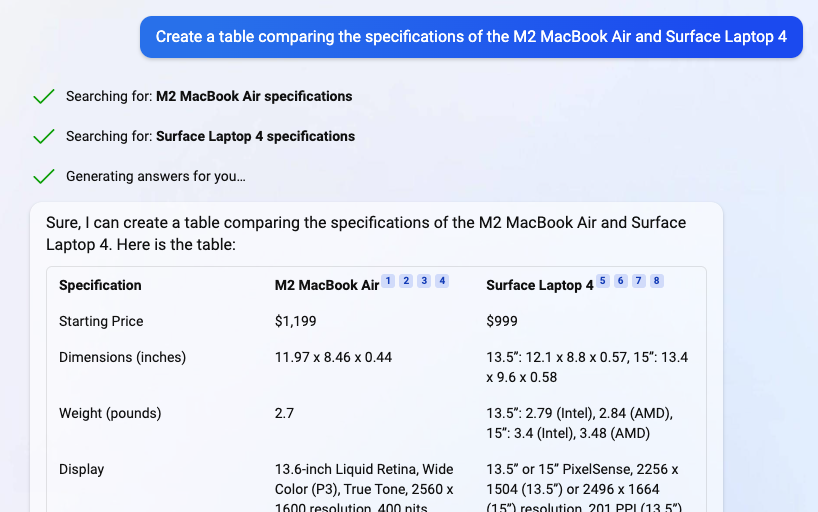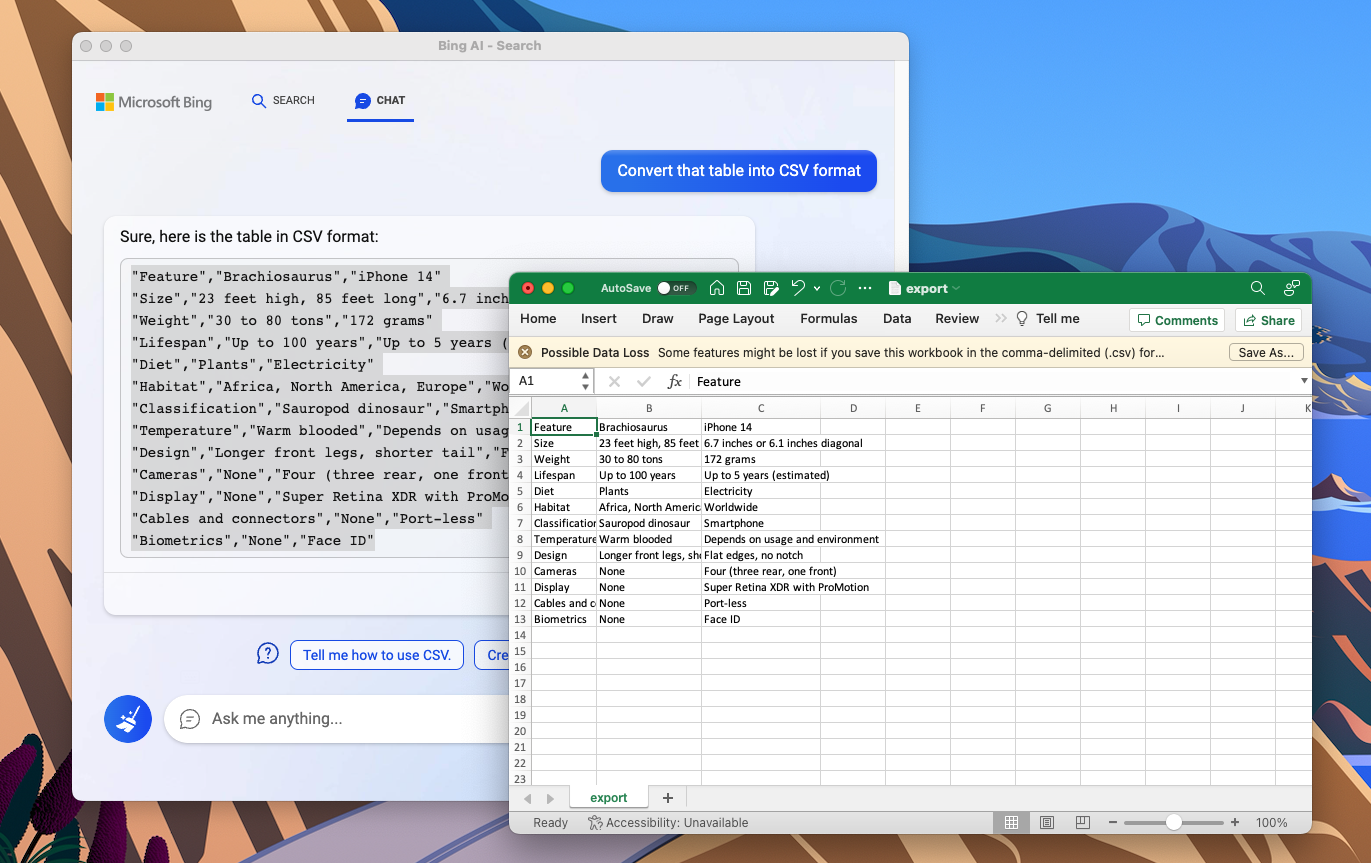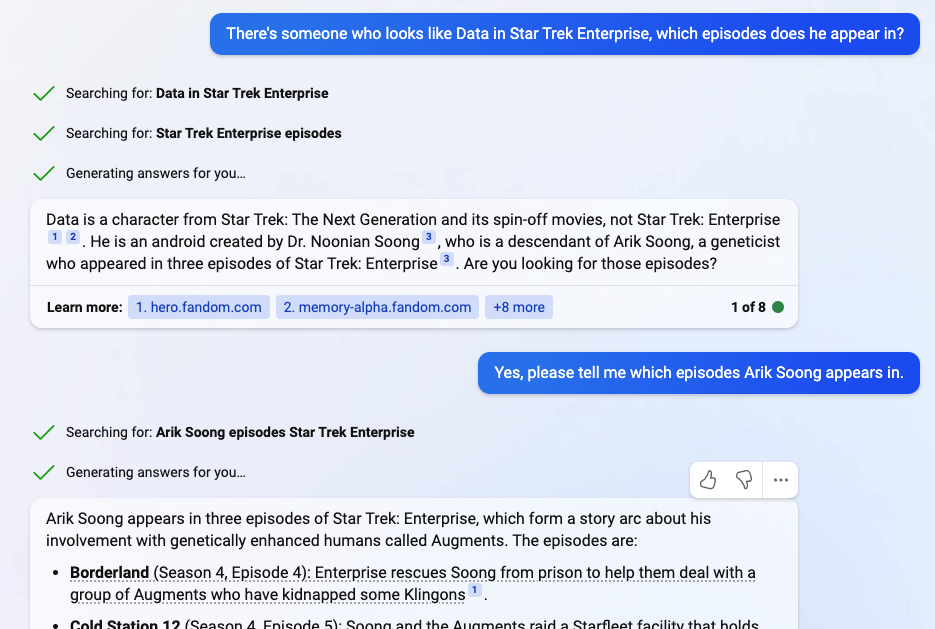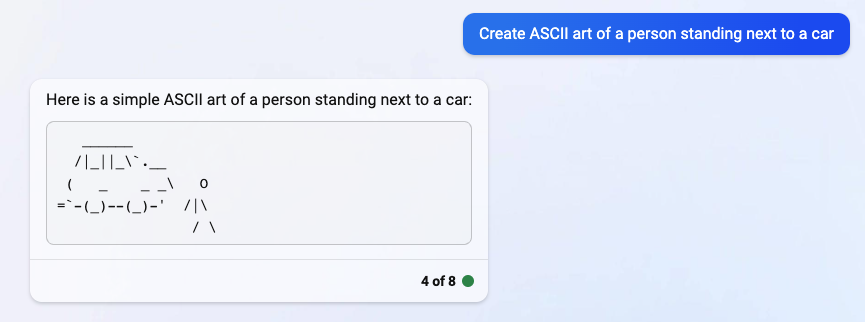
Top 6 Innovative Uses for Microsoft's Bing Chat AI: Unleashing the Power of Conversational Tech

Top 6 Innovative Uses for Microsoft’s Bing Chat AI: Unleashing the Power of Conversational Tech
Quick Links
- Create Comparison Tables
- Multi-step Web Searches
- Draw Text Art
- Date and Time Conversions
- Turn Web Pages Into Quizzes
- Get Up to Speed on Current Events
Microsoft revealed an AI-powered Bing chatbot in February, dubbing it “the new Bing.” But what can you actually do with the new Bing, and where does it fall short?
The new Bing is impressive for an automated tool, as it can not only answer questions in full sentences (or longer paragraphs), but it can also draw information from recent web results. The web features give it an edge over ChatGPT , which has limited knowledge of current events and facts, but it still has problems providing factual answers or helpful responses . That significantly affects its usefulness as a tool, though Bing’s ability to cite sources can help you double-check its responses.
The new Bing chatbot is currently restricted to a waitlist. If you haven’t already been granted access, you’ll need to join the waitlist first.
Even in its current limited state, Bing Chat has at least a few features that are helpful and usually don’t break.
Create Comparison Tables
The primary strength of Bing over ChatGPT and other services is that it can search the web for recent information. It can then process that information into several formats, including comparison tables. The simplest way to do this is to ask something like, “Create a table comparing the specifications of the M2 MacBook Air and Surface Laptop 4.”

With that prompt, Bing will try to guess the most important specifications, and lay them out in an easily readable table format. You can also tweak it by listing variables manually, like “Create a table comparing the specifications of the M2 MacBook Air and Surface Laptop 4, listing the display and ports.” With that example, the only rows of the table are “Display” and “Ports.”
If you’re trying to compare two products or objects in the same field, like Arch Linux and Ubuntu or Wi-Fi and Ethernet , there are probably guides written by real humans that can offer more insight than Bing. However, the feature is still helpful for comparisons that might not exist in written content, or quickly checking one or two specific details across a wide range of devices. You also still need to check the citations, because Bing isn’t perfect at interpreting web pages.

This feature can also be entertaining if you ask Bing to compare two things that no one would ever have a reason to compare. Ask it to lay out the differences between a phone and a dinosaur, or a car and a pencil. You’ll almost always get some funny results.

If the data is helpful and accurate, you can also export it for use in a document or other resource. Try asking it “Convert that table into Markdown format” or “Convert that table into HTML format.” You can ask for CSV format, which you can then copy and paste into a text editor (like Notepad) and save as a .CSV file for use with applications like Microsoft Excel and LibreOffice Calc. It wouldn’t surprise me if Microsoft eventually adds a built-in “Open in Excel” button for table results.
This conversion method usually causes the citations to be lost, but you can retain them by asking something like, “Convert that table to CSV, and include the citations in a row.”

Opening a .CSV file in Excel with data pasted from Bing’s CSV export
Again, you should always check Bing’s citations to make sure the information is correct. For example, with tech products like iPhones, I’ve found Bing often citing old articles about rumored details rather than finalized specifications or product pages.
Multi-step Web Searches
Bing’s greatest strength might be its ability to convey information in a single response that normally takes several web searches. For example, let’s say I’m watching Star Trek: Enterprise, and I see a character who I recognize as being played by the actor who played the android Data in Star Trek: The Next Generation, but the character in this show is not Data.
If I’m curious who that is and when they will appear again in the show, I might need find the actor’s name first (which would give me Brent Spiner ), then I can look him up in IMDB, the Star Trek fan wiki, or another resource to see a list of his appearances in Enterprise. If I already know the character or actor’s name, that takes one step out of the process, but it’s still something that will require some fact-finding with a search engine.

Meanwhile, I asked Bing “There’s someone who looks like Data in Star Trek Enterprise, which episodes does he appear in?” Bing Chat correctly identified that Spiner plays Arik Soong in Star Trek Enterprise, and why he was cast in the role: “[Data] is an android created by Dr. Noonian Soong, who is a descendant of Arik Soong, a geneticist who appeared in three episodes of Star Trek: Enterprise.” Bing then provided a list of episodes with Arik Soong, citing IMDB and various fan wikis.
There are other examples of this with more practical purposes, but if it’s an important question, you need to double-check Bing’s logic. I asked Bing to tell me the minimum box size I would need to ship a Nintendo Switch Lite and an M1 MacBook Air, and it checked the web for the dimensions of both devices to produce an answer: 8.51 by 8.18 by 1.43 inches. The answer didn’t include padding, which would definitely be needed if I was shipping those items, but Bing did in fact tell me “you may also want to consider adding some padding or cushioning materials.”
Related: Bing Chat AI Is a Surprisingly Good Travel Agent
Draw Text Art
ASCII art is a form of artwork that relies on text characters, popularized by command-line tools and other computer software. Bing can generate ASCII art from a provided prompt, and some requests like “Create ASCII art of a person standing next to a car” work well. It’s worth noting that this might be closer to plagiarism than regular AI art -- the car is identical to artwork attributed to Jane Wakenshaw on the ASCII Art Archive .

The art generator seems to fail more often than it works, though. I asked for “ASCII art of an iPad next to a person,” which created a stick figure next to a rectangle. Modifying that to be a person holding an iPad created roughly the same image, but with two lines branching off from the top of the rectangle.

Maybe the lines could be arms? It looks more like a person standing next to a tent. Oh well.
Date and Time Conversions
Time zone conversions can be tricky, especially when the difference is enough to shift the date, or when one place is following Daylight Savings Time (DS) and another place is not. Bing can easily handle these conversions, usually while explaining the logic involved.
To be fair, converting from one zone to another is also something that Google Search, regular Bing, Wolfram Alpha , Time.is , and other tools can usually handle. Bing Chat isn’t breaking any new ground here, but you can feed it into other Bing features. For example, if you’re planning an event for a certain time, Bing Chat can do a batch conversion and present the data in different formats or writing styles.

Opening a .CSV file in Excel with data pasted from Bing’s CSV export
I still prefer Time.is for most time-related tasks, especially since the link for an event can be shared, but I haven’t noticed Bing providing incorrect data for time conversions yet.
Turn Web Pages Into Quizzes
Multiple-choice quizzes or flash cards can be a helpful tool for studying, but the process of converting notes, web resources, or book chapters into actionable data can be time-intensive. That process in itself can sometimes help you memorize information, but Bing can also quiz you on any provided data.
Bing is inconsistent with how it generates answers to prompts about quizzes, sometimes choosing to give you all the questions and answers in one statement (which you then have to handle yourself), and sometimes starting an interactive quiz. I’ve had the best luck with getting the latter format by asking “Quiz me with multiple choices based on this page only:” followed by a pasted web address.

Even when saying “this page only,” Bing will sometimes use data from similar web pages. For example, I asked it to quiz me about a How-To Geek article, which also pulled in a post on Twitter that linked to the article. There seems to be no way to fully override this except to use the Bing sidebar in Microsoft Edge (only the Canary and Dev versions have Bing, as of March 2023).
To use the more reliable implementation in Microsoft Edge, go to a web page, click the Bing button to open the sidebar, and ask Bing to “quiz me with multiple choices based on this page.” You then need to click the “Retry for this page only” button, which will force Edge to not search the web for additional data.

I’ve still encountered a few bugs in this mode where data is pulled from elsewhere – Bing asked me about the core temperature of the Sun from a How-To Geek article about collecting DVDs . There’s a chance Microsoft has fixed those problems by the time you read this article.
Get Up to Speed on Current Events
Every once in a while, there will be something that everyone is talking about and simultaneously requires a detailed explanation of context to understand. If it’s a news topic, recent articles usually include recent context as you read past the first few sentences, but not always. Bing can be helpful in circumstances where you have no clue what is going on, and recent news coverage isn’t helping.

Usually, you can ask something like “explain Sweden in NATO,” and Bing will describe the topic in a few sentences. As with all of Bing’s responses, make sure to check the citation links and ensure they are reputable sources that you trust. I’ve also found that Bing occasionally pulls data from outdated news articles, so if you’re asking about an ongoing situation in the news, it may tell you outdated information.
Also read:
- [New] The Battle of Accessible Viewerships Google Vs. Samsung Headsets
- [Updated] Screencast Essentials From Basics to Advanced Tactics
- 2024 Approved Low-Fee Android Communication Options, 10 Best
- 2024 Approved The Ultimate Path to Crafting Killer Podcast Names, Plus Inspiration Sparks
- Boost Your Audio Experience Easy-Peasy: New Nahimic Driver Version Available
- Guide Complet Pour Rechercher Des Fichiers Disparus Dans Windows 10 Et 11 - 8 Techniques Essentielles
- In 2024, Transforming SRT A Complete Reference Guide for Conversion
- In 2024, Unearthed 30 Window 11 Insider Strategies to Boost Performance
- Overcoming Challenges with Your DHCP Server - Effective Strategies for Restoring Connectivity
- Unfolding Cinema Narratives for 2024
- Unlocking TikTok's Secrets: 10 Steps to Make Your Videos Go Viral
- Title: Top 6 Innovative Uses for Microsoft's Bing Chat AI: Unleashing the Power of Conversational Tech
- Author: Mark
- Created at : 2024-12-31 17:23:51
- Updated at : 2025-01-02 16:46:58
- Link: https://some-guidance.techidaily.com/top-6-innovative-uses-for-microsofts-bing-chat-ai-unleashing-the-power-of-conversational-tech/
- License: This work is licensed under CC BY-NC-SA 4.0.